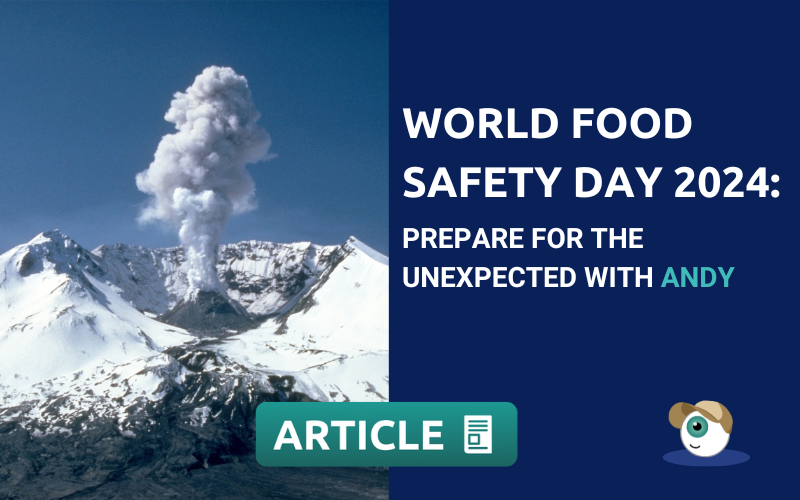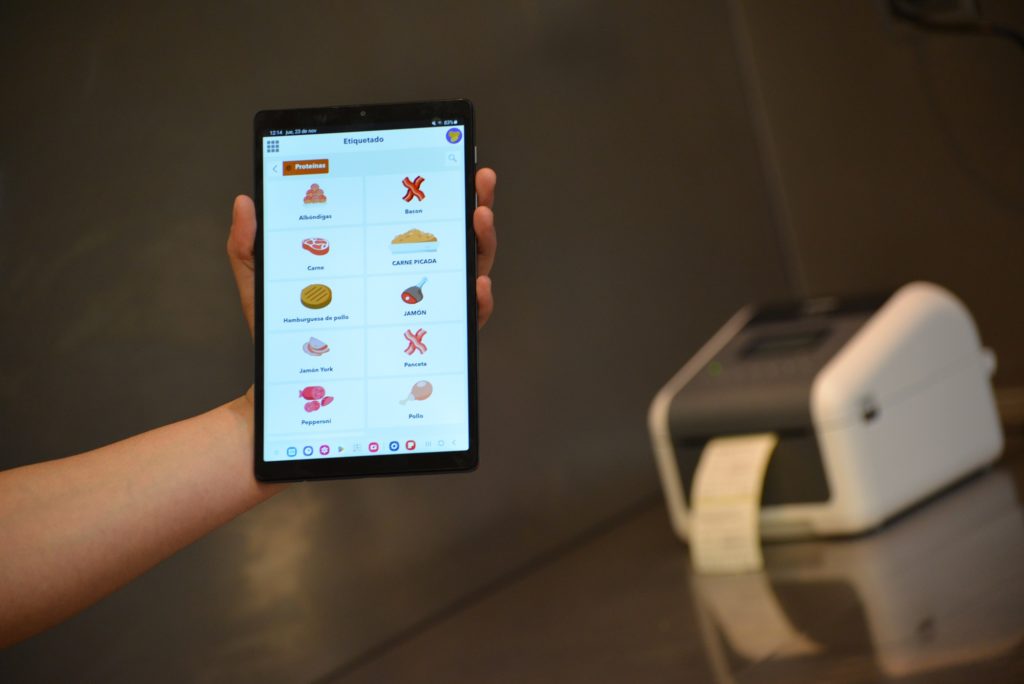World Food Safety Day 2024: Prepare for the unexpected!

Even under seemingly predictable circumstances, the World Health Organization estimates that 1 in 10 people globally fall sick from foodborne illnesses every year. That’s a staggering number, and it paints a concerning picture of vulnerabilities within our food system.
Now, consider the potential impact of unexpected events.
Power outages, natural disasters, supply chain disruptions – these are just a few examples of unforeseen circumstances that can throw a wrench into the delicate balance of food safety. Recognising this ever-present risk, authorities worldwide are focusing World Food Safety Day 2024 on the theme:
“Food safety: prepare for the unexpected.”
This year’s theme underscores the critical importance of being prepared for food safety incidents, no matter how mild or severe they may be.
Food safety incidents can arise from a variety of causes, including accidents, inadequate controls within the food chain, deliberate food fraud, or even natural disasters.
While policymakers, food safety authorities, farmers, and food businesses all play crucial roles in mitigating these risks, consumers like you and me also have a significant part to play in safeguarding our own well-being.
Let’s delve deeper into this crucial topic, exploring the unexpected threats to food safety, preventative measures we can take, and the role innovative tools like Andy can play in keeping us all safe.
The Unexpected Strikes: Common Food Safety Incidents
While we strive for a consistent and reliable food system, unforeseen circumstances can disrupt this delicate balance. These unexpected events can introduce food safety risks that require us to be prepared.
Let’s explore some common food safety incidents and how we can navigate them:
- Power Outages and Spoilage: Our refrigerators and freezers play a vital role in keeping food safe by inhibiting bacterial growth. However, unexpected power outages can disrupt this crucial function, leading to food spoilage and potential health risks.
Here’s what you can do:- Be Prepared: Invest in a reliable food thermometer to check the internal temperature of potentially spoiled foods. Foods within the “danger zone” 4°C – 60°C (40°F – 140°F) for more than 4 hours should be discarded.
- Proper Storage: During an outage, keep refrigerator and freezer doors closed as much as possible to maintain internal temperature. A full freezer will retain coolness longer than an empty one.
- Safe Defrosting: If necessary, thaw frozen food safely in the refrigerator or under cold running water. Never thaw food at room temperature.
- Natural Disasters and Food Contamination: Floods, hurricanes, and other natural disasters can have a devastating impact on food safety. Floodwaters can contaminate crops, livestock, and food storage facilities with harmful bacteria.
Here are some ways to stay safe:- Disaster Preparedness Kit: Include a non-perishable food supply and bottled water in your emergency kit to ensure access to safe food during a disaster.
- Safe Food Handling Practices: If your food supply comes into contact with floodwaters, discard it. When unsure about the safety of food, err on the side of caution and throw it away.
- Stay Informed: Follow official advisories from local authorities regarding the safety of food and water sources in your area after a disaster.
- Supply Chain Disruptions and Recalls: Disruptions in the food supply chain, caused by factors like transportation issues or contamination events, can lead to product recalls. Consuming recalled products poses a potential health risk. Here’s how to stay informed:
- Stay Vigilant: Check food recall notices from trusted sources like the FDA website or mobile app or your corresponding authority if outside the US to stay updated on potentially contaminated products.
- Rotate Stock: Rotate your pantry and refrigerator stock regularly to avoid consuming expired or potentially recalled items.
- Safe Disposal: When encountering a recalled product, follow the recommended disposal instructions to prevent further contamination.
- Accidental Cross-Contamination: Cross-contamination occurs when harmful bacteria spread from one food item to another. This can happen through improper handling practices in the kitchen. Here are some ways to prevent it:
- Separate Your Surfaces: Use designated cutting boards and utensils for raw meat, poultry, and seafood to avoid transferring bacteria to other food items.
- Wash Thoroughly: Always wash your hands thoroughly with soap and warm water for at least 20 seconds before and after handling food.
- Cleanliness is Key: Sanitise cutting boards and utensils with a bleach solution after handling raw meat, poultry, and seafood.
By understanding these unexpected threats and taking proactive measures, we can minimize the risk of foodborne illness and ensure a safe and enjoyable dining experience, even when the unexpected strikes.
Food Safety Emergency Action Plans in Food Service Business
World Food Safety Day serves as a crucial reminder for everyone, from individual consumers to food service businesses, to prioritise food safety. While common food safety incidents at home at dangerous enough in times of emergency, the stakes are even higher in professional kitchens.
Foodborne illnesses can have a devastating impact on restaurants, cafes, and other food service establishments, causing closures, financial losses, and reputational damage.
This is where a robust Food Safety Emergency Action Plan (FSEAP) becomes an essential tool.
An FSEAP outlines a clear course of action for food service businesses in the event of unexpected events that could compromise food safety.
Here’s why an FSEAP is crucial:
- Preparedness is Key: Unexpected situations like power outages, equipment malfunctions, or natural disasters can disrupt normal operations. An FSEAP ensures staff knows exactly what steps to take to minimise food safety risks during these incidents.
- Protecting Public Health: By having a documented plan, food service businesses can take swift action to prevent contaminated food from reaching customers, safeguarding public health and minimizing the potential for foodborne illness outbreaks.
- Minimising Losses: A well-defined FSEAP can help mitigate financial losses associated with food spoilage or product recalls. The plan can outline procedures for proper food handling, storage, and disposal during emergencies, reducing wasted inventory.
- Regulatory Compliance: Many regulatory bodies require food service establishments to have a documented FSEAP in place. Having a plan demonstrates a commitment to food safety and compliance with relevant regulations.
Developing a Food Safety Emergency Action Plan
Here are some key steps for foodservice businesses to consider when developing an FSEAP:
- Identify Potential Threats: Conduct a risk assessment to identify potential food safety hazards specific to your operation. This could include power outages, equipment failures, natural disasters, and even human error.
- Establish Procedures: For each identified threat, create clear and concise procedures for handling the situation. This includes instructions for food storage, handling, and disposal during emergencies.
- Communication is Key: Ensure all staff members are familiar with the FSEAP and understand their roles and responsibilities during an emergency. Regularly conduct training sessions to reinforce the plan and keep staff informed.
- Testing and Revision: Regularly test your FSEAP through practice drills to identify areas for improvement. Update the plan as needed to reflect changes in your operation or regulations.
By implementing a comprehensive Food Safety Emergency Action Plan, food service businesses can demonstrate their commitment to safeguarding public health, minimising risk, and ensuring a safe and enjoyable dining experience for their customers.
World Food Safety Day: Building a Culture of Food Safety is a Shared Responsibility
The responsibility for ensuring food safety extends far beyond individual kitchens and restaurants. It’s a collaborative effort that requires a united front from consumers, foodservice businesses, and governing bodies.
Here’s how each player contributes to a safer food system:
Collaboration for a Seamless Chain:
- Consumers: By staying informed about safe food handling practices, proper storage techniques, and following recall notices, consumers play a vital role in minimizing risks at the end point of the food chain.
- Foodservice Businesses: Implementing and adhering to rigorous food safety protocols, including HACCP (Hazard Analysis and Critical Control Points) plans, regular sanitation procedures, and proper staff training, is paramount for businesses. Developing and implementing a robust Food Safety Emergency Action Plan (FSEAP) as discussed earlier adds another layer of protection during unexpected events.
- Governing Bodies: Regulatory bodies play a crucial role in establishing and enforcing food safety standards across the industry. They also play a part in educating consumers and fostering collaboration between different stakeholders.
By working together, each link in the food chain can strengthen overall food safety practices, minimising the risk of outbreaks and ensuring a safe and healthy food system for all, as promoted this year’s World Food Safety Day.
Andy: your Food Safety and Operational Excellence Digital Assistant
World Food Safety Day 2024’s theme, “Prepare for the unexpected,” underscores the critical need for food service businesses to be proactive in safeguarding their operations.
While a robust Food Safety Emergency Action Plan (FSEAP) is a crucial first step, digital food safety and operational excellence assistants like Andy can be invaluable allies in ensuring preparedness for the unexpected.
Here’s how our food safety and operational excellence Digital Assistant Andy empowers food service businesses to navigate unforeseen challenges:

Action Plans at Your Fingertips: Imagine having your FSEAP readily available at all times, accessible to staff across different locations. Andy can store your FSEAP electronically, allowing for easy access and reference during emergencies. This ensures everyone on your team knows the exact steps to take, minimising confusion and ensuring a swift and coordinated response.
Documentation Made Easy: Maintaining meticulous records is essential for food safety compliance. HACCP plans, temperature logs, training records, and sanitation checklists can all be stored electronically within Andy’s secure platform. This eliminates the risk of lost paperwork and simplifies the auditing process.
Real-time Monitoring and Alerts: Unexpected events like power outages or equipment failures can have a significant impact on food safety.
Andy can be configured to monitor critical parameters like refrigerator and freezer temperatures. In the event of deviations beyond safe ranges, Andy can trigger immediate alerts, allowing staff to take corrective action before food spoilage occurs.
Data-driven Decision Making: Food safety incidents often leave a trail of valuable data. Andy can analyse data from temperature logs, inventory control, and even staff training records to identify potential weaknesses in your food safety protocols. These insights can be used to proactively address risks and prevent future incidents.
Enhanced Communication and Collaboration: During emergencies, clear and efficient communication is vital. Andy can facilitate communication between staff members, managers, and even regulatory bodies in real-time. This ensures everyone is on the same page, allowing for a coordinated and effective response.
A Commitment to Continuous Improvement: The food safety landscape is constantly evolving, and Andy can help your business stay ahead of the curve. By staying connected to relevant databases and regulations, Andy can provide updates on emerging foodborne illness threats and HACCP best practices. This ensures your food safety protocols are always up-to-date and reflect the latest industry standards.
A digital food safety and operational excellence assistant like Andy is a valuable ally in building a culture of food safety within your foodservice business.
By providing instant access to critical information, facilitating real-time monitoring, and promoting data-driven decision-making, Andy empowers businesses to be better prepared for the unexpected, safeguarding public health and ensuring a safe and enjoyable dining experience for their customers.
👉🏽START YOUR FREE TRIAL WITH ANDY NOW👈🏽

